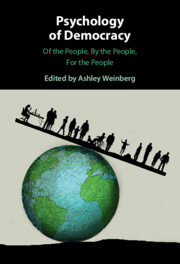Book contents
- Psychology of Democracy
- Psychology of Democracy
- Copyright page
- Contents
- Figures
- Tables
- Contributors
- Preface
- Acknowledgements
- Chapter 1 Psychology of Democracy
- Part I Of the People
- Part II By the People
- Chapter 8 Trust in Political Institutions and Support for Authoritarianism
- Chapter 9 New Technology, Language and Gesture in Contemporary Indian Political Discourse
- Chapter 10 Fact or Fiction
- Chapter 11 Dissecting the Psychology of a Voter
- Chapter 12 Building Trust through a Revolving Door of Leaders:
- Chapter 13 After the Party Is Over
- Part III For the People
- Index
- References
Chapter 9 - New Technology, Language and Gesture in Contemporary Indian Political Discourse
from Part II - By the People
Published online by Cambridge University Press: 24 February 2022
- Psychology of Democracy
- Psychology of Democracy
- Copyright page
- Contents
- Figures
- Tables
- Contributors
- Preface
- Acknowledgements
- Chapter 1 Psychology of Democracy
- Part I Of the People
- Part II By the People
- Chapter 8 Trust in Political Institutions and Support for Authoritarianism
- Chapter 9 New Technology, Language and Gesture in Contemporary Indian Political Discourse
- Chapter 10 Fact or Fiction
- Chapter 11 Dissecting the Psychology of a Voter
- Chapter 12 Building Trust through a Revolving Door of Leaders:
- Chapter 13 After the Party Is Over
- Part III For the People
- Index
- References
Summary
In the field of language and gesture studies, it is noteworthy that no research-based studies of politicians or other public figures have been undertaken in the Indian context. This absence is particularly striking given that India is the world’s largest democracy, with as much lively diversity in its styles of political campaigning as in its linguistic and cultural structures. This chapter is an attempt to fill this lacuna. The span of time considered in the present analysis is the four-year period dating from before Narendra Modi became Prime Minister to just before he was elected to a second term. My suggestion is that this short period was pivotal in modern Indian politics because a primary tool of human communication, namely language, came to be conjoined with a dazzling set of new technologies. I present results from a study of Modi’s speeches and gestures and show how this has also had a significant effect on a younger generation of Indian leaders and obliged them to define their own styles of technologically mediated leadership, with interesting consequences. I end by offering researchers a putative general framework for the study of political gestures as they influence both national narratives and the personal stances of individual politicians.
- Type
- Chapter
- Information
- Psychology of DemocracyOf the People, By the People, For the People, pp. 195 - 228Publisher: Cambridge University PressPrint publication year: 2022
References
- 4
- Cited by

